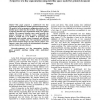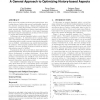1559 search results - page 131 / 312 » The Semantics of Future and Its Use in Program Optimizations |
HIPEAC
2007
Springer
15 years 1 months ago
2007
Springer
Fine-grained program power behavior is useful in both evaluating power optimizations and observing power optimization opportunities. Detailed power simulation is time consuming and...
CIVR
2008
Springer
14 years 11 months ago
2008
Springer
As the consequence of semantic gap, visual similarity does not guarantee semantic similarity, which in general is conflicting with the inherent assumption of many generativebased ...
ICDAR
2011
IEEE
13 years 9 months ago
2011
IEEE
—This paper proposes a model-based text line segmentation algorithm for machine-printed document images. The model is based on geometric configuration which uses the interline sp...
ASPLOS
2004
ACM
15 years 3 months ago
2004
ACM
Transactional Coherence and Consistency (TCC) offers a way to simplify parallel programming by executing all code within transactions. In TCC systems, transactions serve as the fu...
AOSD
2009
ACM
15 years 4 months ago
2009
ACM
Many aspects for runtime monitoring are history-based: they contain pieces of advice that execute conditionally, based on the observed execution history. History-based aspects are...


